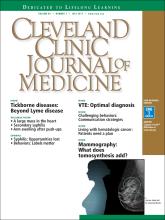A healthy 16-year-old boy presented with muscle pain and weakness in the chest and both arms after performing 50 push-ups daily for 3 days, and the symptoms did not seem to improve after 3 days.
He denied dark urine or drug abuse. Physical examination revealed swelling of both arms and the chest, with tenderness and weakness in the triceps brachii, deltoid, and pectoralis major muscles (Figure 1). Laboratory testing showed a creatine kinase level of 59,380 U/L (reference range 30–220). T2-weighted magnetic resonance imaging (MRI) showed diffuse hyperintensity in all affected muscles (Figure 2) with hyperintensity on T1-weighted images, findings consistent with rhabdomyolysis. The rhabdomyolysis was deemed to have been induced by exercise, in our patient’s case by push-ups.
Initial visit: The patient showed swelling in the triceps brachii, deltoid, and pectoralis major muscles.
T2-weighted magnetic resonance imaging showed diffuse hyperintensity in both triceps brachii muscles (arrows).
Treatment with aggressive fluid transfusion was started, with strict monitoring of fluid input and urine output. There was no evidence of acute renal failure or hyperkalemia. The creatine kinase level improved progressively: to 28,734 U/L on day 2, 15,386 U/L on day 3, and 11,472 U/L on day 4. By 2 weeks after symptom onset, the level had normalized (164 U/L), and all symptoms had resolved. The patient was able to resume exercising.
EXERCISE-INDUCED RHABDOMYOLYSIS
Approximately 50% of patients with rhabdomyolysis present with the characteristic triad of myalgia (84%), muscle weakness (73%), and dark urine (80%), and 8.1% to 52% present with muscle swelling.1 Rhabdomyolysis may be caused by exercise,2 and risk factors include physical deconditioning, high ambient temperature, high humidity, impaired sweating (due to anticholinergic drugs), sickle cell trait, and hypokalemia from sweating.2 Pain and swelling of the affected focal muscles is the chief complaint.3
Although acute renal failure in exercise-induced rhabdomyolysis is rare, failure to recognize rhabdomyolysis can cause diagnostic delay and inappropriate treatment.4
In healthy people, exercise-induced muscle damage begins to resolve within 1 to 3 days.5,6 Physicians should suspect exercise-induced rhabdomyolysis in patients with prolonged muscle swelling and tenderness in affected muscles that lasts longer than expected.7
- Copyright © 2017 The Cleveland Clinic Foundation. All Rights Reserved.








